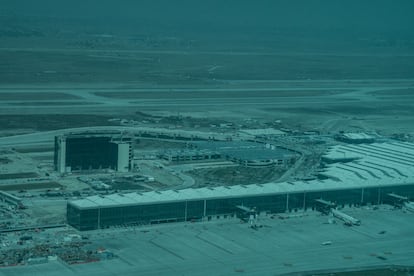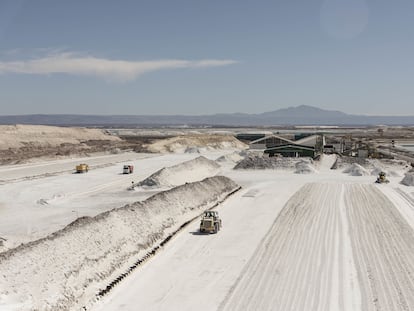Mexico’s new international airport gets ready for takeoff
On March 21, the three runways at the General Felipe Ángeles Airport will begin to operate, after a two-year, 10-month construction project


Mexico’s new airport, Felipe Ángeles International (AIFA), now has an opening date: March 21. The moment marks the culmination of the first large-scale project of the Mexican government, which invested $2.6 billion in the project. Against all odds, the airport was finished in two years and 10 months. The new facility is located in the municipality of Zumpango and is aimed at easing the air traffic to Mexico City, which is 45 kilometers away.
In early February, workers were still putting up the passenger terminal and building the pathways to get there. Others were laying down the ground markings on the runway. The visibility was poor, but the main elements of AIFA could be seen: a control tower, two runways for civilian flights and one for military operations, a terminal, a hotel, a parking station, a loading station and fuel tanks. Next to the facility is the Santa Lucía Air Force Base.
Operations at AIFA will kick off with eight national flights, with passengers from the cities of Monterrey, Guadalajara, Cancún and Tijuana (both arrivals and departures), as well as two international freight operations from the United States. AIFA’s job is to ease the pressure on Mexico City International Airport (AICM), which received 36 million passengers in 2021. In 2019, AICM had already exceeded the recommended security levels, with 50 million travelers recorded. The coronavirus pandemic and the suspension of Interjet operations in 2020 gave the airport some breathing space, but as activity returns to normal, pressure is inevitable.
To address this issue, the government of former Mexican president Enrique Peña Nieto announced the construction of a new airport in Texcoco, 25 kilometers from the capital, which was expected to cost $13 billion. But in 2018, when the work was 30% completed, the current Mexican president, Andrés Manuel López Obrador, pulled the plug and proposed the airport be built on part of the land that makes up the Santa Lucía Air Force Base. He wanted financing for the construction to come out of the national budget – instead of relying on debt – and he tasked the armed forces with building the airport.
Before AIFA, soldiers in Mexico had only ever built schools, hospitals and homes. The airport became the first in a series of large-scale construction projects to be undertaken by the armed forces. Away from the violence, the fight against drug trafficking and their other jobs, the soldiers – engineers and architects in army green – began building the airport on April 29, 2019. With nearly 30 days to the opening, the soldiers proudly declared the mission complete. “It seemed like a mission impossible, but it isn’t,” one of them said. The airport is named after Felipe Ángeles, a general in the 1910 Mexican Revolution, and will open on March 21, the birthday of esteemed Mexican leader Benito Juárez, the president who instituted the separation of Church and state.
Military management
The Mexican government created the company AIFA, SA de CA, which is run by the National Defense Department, and this body is in charge of the contracts with the providers of the terminal area. López Obrador is planning the armed forces to continue to play a key role in the airport, after its opening, describing the facility as “the institution of the institutions.” It will be up to the armed forces to manage the future extension of the terminal and the traffic of up to 80 million passengers.
But for Felipe Ángeles International Airport to offer international routes, the Mexican government must first hear back from the US Federal Aviation Administration (FAA). In May 2021, the FAA downgraded Mexico’s safety rating from Category 1 to Category 2, after an assessment found that the country’s aviation authority did not meet International Civil Aviation Organization (ICAO) safety standards. This has stopped Mexican airlines from opening new international routes to the US and operating codeshare flights with US airlines. Mexican airlines such as Viva Aerobús, Volaris and Aeroméxico, however, have already signed up to operate some national flights from the new airport.
Tu suscripción se está usando en otro dispositivo
¿Quieres añadir otro usuario a tu suscripción?
Si continúas leyendo en este dispositivo, no se podrá leer en el otro.
FlechaTu suscripción se está usando en otro dispositivo y solo puedes acceder a EL PAÍS desde un dispositivo a la vez.
Si quieres compartir tu cuenta, cambia tu suscripción a la modalidad Premium, así podrás añadir otro usuario. Cada uno accederá con su propia cuenta de email, lo que os permitirá personalizar vuestra experiencia en EL PAÍS.
¿Tienes una suscripción de empresa? Accede aquí para contratar más cuentas.
En el caso de no saber quién está usando tu cuenta, te recomendamos cambiar tu contraseña aquí.
Si decides continuar compartiendo tu cuenta, este mensaje se mostrará en tu dispositivo y en el de la otra persona que está usando tu cuenta de forma indefinida, afectando a tu experiencia de lectura. Puedes consultar aquí los términos y condiciones de la suscripción digital.
More information
Últimas noticias
Maduro pleads not guilty before the federal court in New York: ‘I am still the president of Venezuela’
A new test can detect Alzheimer’s from a finger prick
UN team enters Sudanese city of El Fasher after paramilitary massacre: ‘It’s like a ghost town’
A recipe for resistance: Indigenous peoples politicize their struggles from the kitchen
Most viewed
- Gilles Lipovetsky: ‘If you want to live better and fall in love, take Prozac, don’t look to philosophy’
- Alain Aspect, Nobel laureate in physics: ‘Einstein was so smart that he would have had to recognize quantum entanglement’
- Alvin Hellerstein, a 92-year-old judge appointed by Bill Clinton, to preside over Maduro’s trial in New York
- Maduro’s downfall puts China’s relationship with Venezuela to the test
- Why oil has been at the center of Venezuela-US conflicts for decades










































